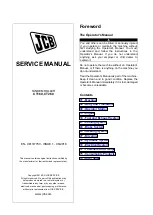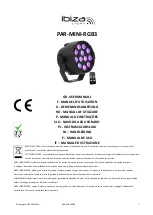
TEST NO. 2: Implement Relief Pressure (Fig. 9)
Using a low pressure gauge: 0 - 1000 psi
1. Perform steps 1 - 7 under Charge Pressure Test.
2. While observing the gauge, move the lift control lever
to the RAISE position. While holding the lever in the
RAISE position, look at the pressure reading on the
gauge. The gauge should show 700 - 800 psi. Stop the
engine and move the lift control lever to the LOWER
position to lower the implement to the ground.
3. If the pressure is below 700 psi, adjust the implement
relief valve by adding the required amount of shims from
the shim pack.
The implement relief pressure must not ex-
ceed 800 psi.
CAUTION
NOTE: When testing the implement relief valve pres-
sure, it may be found that the pressure is already set to
the 800 psi maximum. If this is so, a slow or no lift
condition is most likely caused by an added force being
applied to the lift system and not a fault within the
hydraulic circuit. This is can be caused by parts that are
binding or build up of debris under the cutting unit. This
adds to the amount of force that the hydraulic cylinder
must overcome. Repair such items before continuing
with the hydraulic tests.
If adding shims to the relief valve does not increase the
pressure, inspect the condition of the charge pump
gerotor and internal housing.
If the charge pump is in good condition (no scoring,
scratches, or excessive wear), the general condition of
the transmission’s piston pump and piston motor might
be suspected of wear and inefficiency.
A lack of sufficient implement pressure could be due to
the fact that the charge pump is having to direct most of
its flow to the main traction circuit (piston pump and
piston motor). When this occurs, oil pressure may not
increase to the 700 - 800 psi pressure necessary to raise
the heavy implement.
At this point, a traction pressure test could be used to
determine whether the hydrostatic transmission has
excessive piston group leakage and needs to be
repaired. (See Traction Pressure Test.)
Testing
Page 5 - 20
Groundsmaster
®
300 Series
Summary of Contents for Groundsmaster 328-D
Page 2: ......
Page 12: ...Torque Specifications Page 2 4 Rev A Groundsmaster 300 Series ...
Page 44: ...Troubleshooting Page 4 16 Groundsmaster 300 Series ...
Page 45: ...Groundsmaster 300 Series Page 4 17 Troubleshooting ...
Page 171: ...Groundsmaster 300 Series Page 6 25 Testing ...
Page 220: ...Repairs Page 7 24 Groundsmaster 300 Series ...
Page 320: ...Troubleshooting Troubleshooting Page 11 4 Groundsmaster 300 Series ...
Page 348: ...Troubleshooting Troubleshooting Page 12 4 Groundsmaster 300 Series ...
Page 379: ...Troubleshooting Groundsmaster 300 Series Page 13 3 Troubleshooting ...
Page 400: ...This page is blank ...
Page 401: ...This page is blank ...
















































